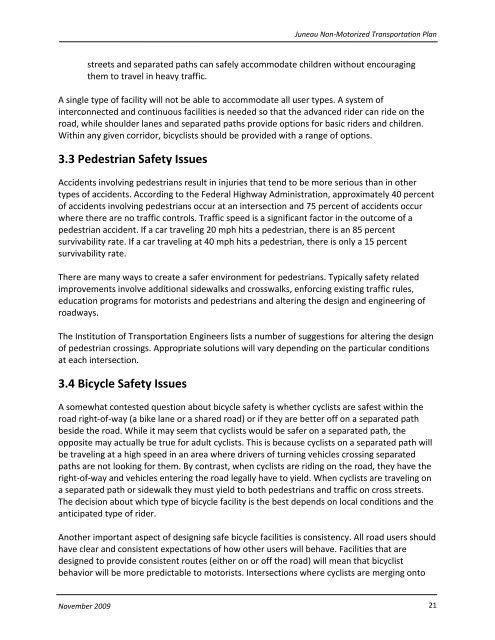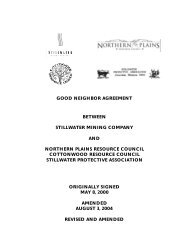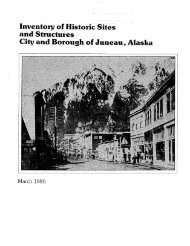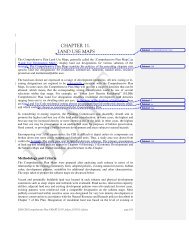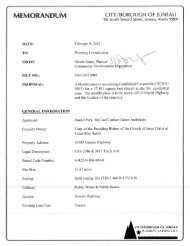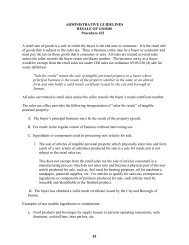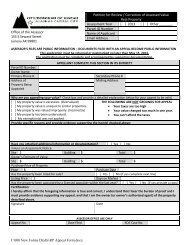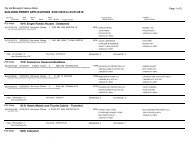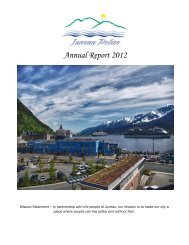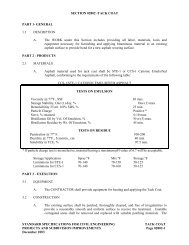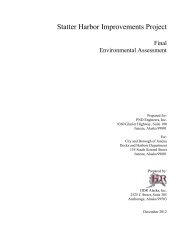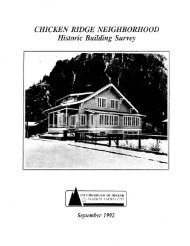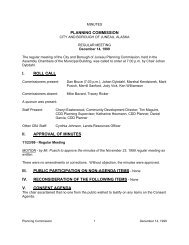Juneau Non-Motorized Transportation Plan - City and Borough of ...
Juneau Non-Motorized Transportation Plan - City and Borough of ...
Juneau Non-Motorized Transportation Plan - City and Borough of ...
You also want an ePaper? Increase the reach of your titles
YUMPU automatically turns print PDFs into web optimized ePapers that Google loves.
<strong>Juneau</strong> <strong>Non</strong>‐<strong>Motorized</strong> <strong>Transportation</strong> <strong>Plan</strong><br />
streets <strong>and</strong> separated paths can safely accommodate children without encouraging<br />
them to travel in heavy traffic.<br />
A single type <strong>of</strong> facility will not be able to accommodate all user types. A system <strong>of</strong><br />
interconnected <strong>and</strong> continuous facilities is needed so that the advanced rider can ride on the<br />
road, while shoulder lanes <strong>and</strong> separated paths provide options for basic riders <strong>and</strong> children.<br />
Within any given corridor, bicyclists should be provided with a range <strong>of</strong> options.<br />
3.3 Pedestrian Safety Issues<br />
Accidents involving pedestrians result in injuries that tend to be more serious than in other<br />
types <strong>of</strong> accidents. According to the Federal Highway Administration, approximately 40 percent<br />
<strong>of</strong> accidents involving pedestrians occur at an intersection <strong>and</strong> 75 percent <strong>of</strong> accidents occur<br />
where there are no traffic controls. Traffic speed is a significant factor in the outcome <strong>of</strong> a<br />
pedestrian accident. If a car traveling 20 mph hits a pedestrian, there is an 85 percent<br />
survivability rate. If a car traveling at 40 mph hits a pedestrian, there is only a 15 percent<br />
survivability rate.<br />
There are many ways to create a safer environment for pedestrians. Typically safety related<br />
improvements involve additional sidewalks <strong>and</strong> crosswalks, enforcing existing traffic rules,<br />
education programs for motorists <strong>and</strong> pedestrians <strong>and</strong> altering the design <strong>and</strong> engineering <strong>of</strong><br />
roadways.<br />
The Institution <strong>of</strong> <strong>Transportation</strong> Engineers lists a number <strong>of</strong> suggestions for altering the design<br />
<strong>of</strong> pedestrian crossings. Appropriate solutions will vary depending on the particular conditions<br />
at each intersection.<br />
3.4 Bicycle Safety Issues<br />
A somewhat contested question about bicycle safety is whether cyclists are safest within the<br />
road right‐<strong>of</strong>‐way (a bike lane or a shared road) or if they are better <strong>of</strong>f on a separated path<br />
beside the road. While it may seem that cyclists would be safer on a separated path, the<br />
opposite may actually be true for adult cyclists. This is because cyclists on a separated path will<br />
be traveling at a high speed in an area where drivers <strong>of</strong> turning vehicles crossing separated<br />
paths are not looking for them. By contrast, when cyclists are riding on the road, they have the<br />
right‐<strong>of</strong>‐way <strong>and</strong> vehicles entering the road legally have to yield. When cyclists are traveling on<br />
a separated path or sidewalk they must yield to both pedestrians <strong>and</strong> traffic on cross streets.<br />
The decision about which type <strong>of</strong> bicycle facility is the best depends on local conditions <strong>and</strong> the<br />
anticipated type <strong>of</strong> rider.<br />
Another important aspect <strong>of</strong> designing safe bicycle facilities is consistency. All road users should<br />
have clear <strong>and</strong> consistent expectations <strong>of</strong> how other users will behave. Facilities that are<br />
designed to provide consistent routes (either on or <strong>of</strong>f the road) will mean that bicyclist<br />
behavior will be more predictable to motorists. Intersections where cyclists are merging onto<br />
November 2009 21


